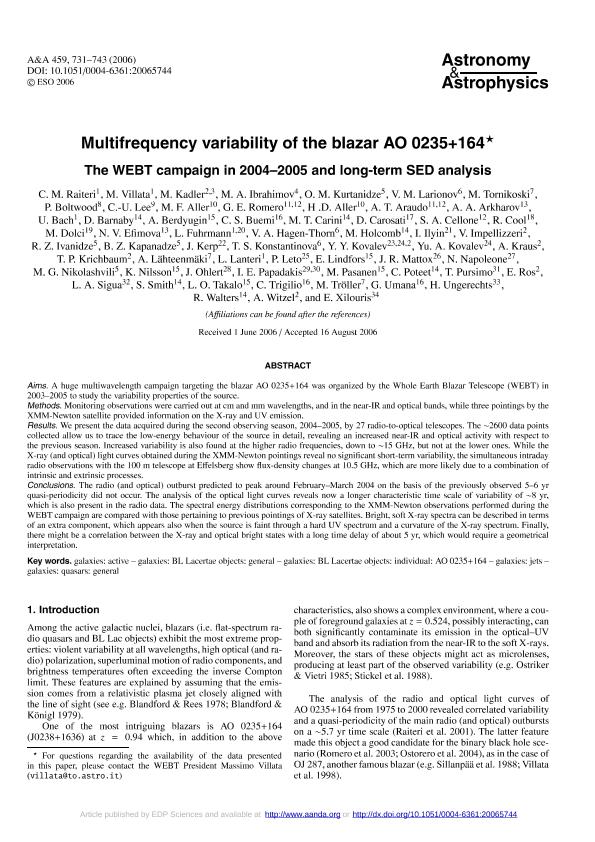Artículo
Multifrequency variability of the blazar AO0235+164. The WEBT campaign in 2004-2005 and long-term SED analysis.
Raiteri, C. M.; Villata, M.; Kadler, M.; Ibrahimov, M. A.; Kurtanidze, O. M.; Larionov, V. M.; Tornikosk, I. M.; Boltwood, P.; Lee, C.-U.; Aller, M. F.; Romero, Gustavo Esteban ; Aller, H. D.; Araudo, Anabella Teresa
; Aller, H. D.; Araudo, Anabella Teresa ; Arkharov, A. A.; Bach, U.; Barnaby, D.; Berdyugin, A.; Buemi, C. S.; Carini, M. T.; Carosati, D.; Cellone, Sergio Aldo
; Arkharov, A. A.; Bach, U.; Barnaby, D.; Berdyugin, A.; Buemi, C. S.; Carini, M. T.; Carosati, D.; Cellone, Sergio Aldo ; Cool, R.; Dolci, M.; Efimova, N. V.; Fuhrmann, L.; Hagen Thorn, V. A.; Holcomb, M.; Ilyin, I.; Impellizzeri, V.; Ivanidze, R. Z.; Kapanadze, B. Z.; Kerp, J.; Konstantinova, T. S.; Kovalev, Y. Y.; Kovalev, Yu. A.; Kraus, A.; Krichbaum, T. P.; Lähteenmäki, A.; Lanteri, L.; Leto, P.; Lindfors, E.; Mattox, J. R.; Napoleone, N.; Nikolashvili, M. G.; Nilsson, K.; Ohlert, J.; Papadakis, I. E.; Pasanen, M.; Poteet, C.; Pursimo, T.; Ros, E.; Sigua, L. A.; Smith, S.; Takalo, L. O.; Trigilio, C.; Tröller, M.; Umana, G.; Ungerechts, H.; Walters, R.; Witzel, A.; Xilouris, E.
; Cool, R.; Dolci, M.; Efimova, N. V.; Fuhrmann, L.; Hagen Thorn, V. A.; Holcomb, M.; Ilyin, I.; Impellizzeri, V.; Ivanidze, R. Z.; Kapanadze, B. Z.; Kerp, J.; Konstantinova, T. S.; Kovalev, Y. Y.; Kovalev, Yu. A.; Kraus, A.; Krichbaum, T. P.; Lähteenmäki, A.; Lanteri, L.; Leto, P.; Lindfors, E.; Mattox, J. R.; Napoleone, N.; Nikolashvili, M. G.; Nilsson, K.; Ohlert, J.; Papadakis, I. E.; Pasanen, M.; Poteet, C.; Pursimo, T.; Ros, E.; Sigua, L. A.; Smith, S.; Takalo, L. O.; Trigilio, C.; Tröller, M.; Umana, G.; Ungerechts, H.; Walters, R.; Witzel, A.; Xilouris, E.
 ; Aller, H. D.; Araudo, Anabella Teresa
; Aller, H. D.; Araudo, Anabella Teresa ; Arkharov, A. A.; Bach, U.; Barnaby, D.; Berdyugin, A.; Buemi, C. S.; Carini, M. T.; Carosati, D.; Cellone, Sergio Aldo
; Arkharov, A. A.; Bach, U.; Barnaby, D.; Berdyugin, A.; Buemi, C. S.; Carini, M. T.; Carosati, D.; Cellone, Sergio Aldo ; Cool, R.; Dolci, M.; Efimova, N. V.; Fuhrmann, L.; Hagen Thorn, V. A.; Holcomb, M.; Ilyin, I.; Impellizzeri, V.; Ivanidze, R. Z.; Kapanadze, B. Z.; Kerp, J.; Konstantinova, T. S.; Kovalev, Y. Y.; Kovalev, Yu. A.; Kraus, A.; Krichbaum, T. P.; Lähteenmäki, A.; Lanteri, L.; Leto, P.; Lindfors, E.; Mattox, J. R.; Napoleone, N.; Nikolashvili, M. G.; Nilsson, K.; Ohlert, J.; Papadakis, I. E.; Pasanen, M.; Poteet, C.; Pursimo, T.; Ros, E.; Sigua, L. A.; Smith, S.; Takalo, L. O.; Trigilio, C.; Tröller, M.; Umana, G.; Ungerechts, H.; Walters, R.; Witzel, A.; Xilouris, E.
; Cool, R.; Dolci, M.; Efimova, N. V.; Fuhrmann, L.; Hagen Thorn, V. A.; Holcomb, M.; Ilyin, I.; Impellizzeri, V.; Ivanidze, R. Z.; Kapanadze, B. Z.; Kerp, J.; Konstantinova, T. S.; Kovalev, Y. Y.; Kovalev, Yu. A.; Kraus, A.; Krichbaum, T. P.; Lähteenmäki, A.; Lanteri, L.; Leto, P.; Lindfors, E.; Mattox, J. R.; Napoleone, N.; Nikolashvili, M. G.; Nilsson, K.; Ohlert, J.; Papadakis, I. E.; Pasanen, M.; Poteet, C.; Pursimo, T.; Ros, E.; Sigua, L. A.; Smith, S.; Takalo, L. O.; Trigilio, C.; Tröller, M.; Umana, G.; Ungerechts, H.; Walters, R.; Witzel, A.; Xilouris, E.
Fecha de publicación:
12/2006
Editorial:
EDP Sciences
Revista:
Astronomy and Astrophysics
ISSN:
0004-6361
Idioma:
Inglés
Tipo de recurso:
Artículo publicado
Clasificación temática:
Resumen
Aims.A huge multiwavelength campaign targeting the blazar AO 0235+164 was organized by the Whole Earth Blazar Telescope (WEBT) in 2003–2005 to study the variability properties of the source. Methods.Monitoring observations were carried out at cm and mm wavelengths, and in the near-IR and optical bands, while three pointings by the XMM-Newton satellite provided information on the X-ray and UV emission. Results.We present the data acquired during the second observing season, 2004–2005, by 27 radio-to-optical telescopes. The ~2600 data points collected allow us to trace the low-energy behaviour of the source in detail, revealing an increased near-IR and optical activity with respect to the previous season. Increased variability is also found at the higher radio frequencies, down to ~15 GHz, but not at the lower ones. While the X-ray (and optical) light curves obtained during the XMM-Newton pointings reveal no significant short-term variability, the simultaneous intraday radio observations with the 100 m telescope at Effelsberg show flux-density changes at 10.5 GHz, which are more likely due to a combination of intrinsic and extrinsic processes. Conclusions.The radio (and optical) outburst predicted to peak around February–March 2004 on the basis of the previously observed 5–6 yr quasi-periodicity did not occur. The analysis of the optical light curves reveals now a longer characteristic time scale of variability of ~8 yr, which is also present in the radio data. The spectral energy distributions corresponding to the XMM-Newton observations performed during the WEBT campaign are compared with those pertaining to previous pointings of X-ray satellites. Bright, soft X-ray spectra can be described in terms of an extra component, which appears also when the source is faint through a hard UV spectrum and a curvature of the X-ray spectrum. Finally, there might be a correlation between the X-ray and optical bright states with a long time delay of about 5 yr, which would require a geometrical interpretation.
Palabras clave:
Active Galaxies
,
Bl Lacertae Objects
,
Ao 0235+164 (Objeto Bl Lac)
,
Jets
,
Quasars
Archivos asociados
Licencia
Identificadores
Colecciones
Articulos(IALP)
Articulos de INST.DE ASTROFISICA LA PLATA
Articulos de INST.DE ASTROFISICA LA PLATA
Articulos(IAR)
Articulos de INST.ARG.DE RADIOASTRONOMIA (I)
Articulos de INST.ARG.DE RADIOASTRONOMIA (I)
Citación
Raiteri, C. M.; Villata, M.; Kadler, M.; Ibrahimov, M. A.; Kurtanidze, O. M.; et al.; Multifrequency variability of the blazar AO0235+164. The WEBT campaign in 2004-2005 and long-term SED analysis.; EDP Sciences; Astronomy and Astrophysics; 459; 3; 12-2006; 731-743
Compartir
Altmétricas



